Study on Mechanism of Stick–Slip Vibration Based on Torque Characteristics of PDC Bit
Abstract
:1. Introduction
2. Working Torque Characteristics of PDC Bit Drilling
3. Materials and Methods
3.1. Influence of the Cutting Structure
3.2. Influence Relationship of Bit Size
4. Study on Torsion Variable Characteristics of PDC Bit Drilling Drill String
4.1. Relationships among Drill String Torsion Variables
4.2. Torsion Velocity Change in the Drill String
5. Mechanism of SV of PDC Bit in Drilling
5.1. Simulation of Torsion of the Bit–Drill String System
5.2. Mechanism and Law of SV of the Drill Bit
6. Conclusions
- (1)
- The working torque of PDC bit has little influence on parameters such as tooth density and blade number. However, it is greatly affected by the depth of intrusion, strength of the rock, and size of the drill bit. The change in the depth of intrusion (or the sudden change in drilling pressure) has a significant impact on the speed of the drill bit.
- (2)
- The fundamental reason for SV of the bit is that the torque on the bit is insufficient to overcome the resistance of the rock and so the dynamic balance is broken. The main factors affecting SV include the change in stratum rock strength, changes in drill string system length and stiffness, change in the WOB load, and vibration of the drill string system.
- (3)
- When the bit resists torque, the bit speed drops or the bit can even stop running; that is, SS occurs. The drill string distorts and starts to accumulate energy. During the slippage stage, the bit speed is notably higher than the rotary table speed.
- (4)
- When the bit resistance torque is constant, the drill string torque from the bottom hole to the wellhead increases gradually. When the bit reaches a certain critical value, the bit will stop for a long time; that is, SS will occur. When the drill string accumulates enough energy, it will break and reach the dynamic balance again.
- (5)
- To minimize damage to the bit from SV, the following three measures can be taken: 1. The auxiliary cutting structure characteristics of the bit (e.g., the compound cutting structure of backup teeth) can be modified to limit the penetration depth of the cutting teeth within a certain range. 2. The bit structure can be optimized by, for example, using a spiral blade to optimize the transverse unbalanced force of the bit. 3. The drilling parameters can be optimized to control the WOB speed under drilling of heterogeneous formations to prevent the occurrence of SV.
Author Contributions
Funding
Data Availability Statement
Acknowledgments
Conflicts of Interest
References
- Teng, X.Q.; Di, Q.F.; Li, N.; Chen, F.; Zhou, B.; Wang, M. Measurement and Analysis of Stick-Slip Characteristics of Drill String in Ultra-Deep Wells. Pet. Drill. Tech. 2017, 45, 32–39. [Google Scholar]
- Kessai, I.; Benammar, S.; Doghmane, M.Z.; Tee, K.F. Drill Bit Deformations in Rotary Drilling Systems under Large-Amplitude Stick-Slip Vibrations. Appl. Sci. 2020, 10, 6523. [Google Scholar] [CrossRef]
- Laib, A.; Gharib, M. Design of an Intelligent Cascade Control Scheme Using a Hybrid Adaptive Neuro-Fuzzy PID Controller for the Suppression of Drill String Torsional Vibration. Appl. Sci. 2024, 14, 5225. [Google Scholar] [CrossRef]
- Monteiro, H.L.S.; Trindade, M.A. Performance analysis of proportional-integral feedback control for the reduction of stick-slip-induced torsional vibrations in oil well drillstrings. J. Sound Vib. 2017, 398, 28–38. [Google Scholar] [CrossRef]
- Ejike, C.; Obuobi, I.F.; Avinu, S.; Abid, K.; Teodoriu, C. Investigation and Analysis of Influential Parameters in Bottomhole Stick–Slip Calculation during Vertical Drilling Operations. Energies 2024, 17, 622. [Google Scholar] [CrossRef]
- Hosseinzadeh, A.; Bakhtiari-Nejad, F. A New Dynamic Model of Coupled Axial–Torsional Vibration of a Drill String for Investigation on the Length Increment Effect on Stick–Slip Instability. J. Vib. Acoust. 2017, 139, 061016. [Google Scholar] [CrossRef]
- Kovalyshen, Y. Experiments on Stick-Slip Vibrations in Drilling with Drag Bits. In Proceedings of the 48th U.S. Rock Mechanics/Geomechanics Symposium, Minneapolis, MN, USA, 1–4 June 2014. [Google Scholar]
- Richard, T.; Detournay, E.; Fear, M.; Miller, B.; Clayton, R.; Matthews, O. Influence of Bit-Rock Interaction on Stick-Slip Vibrations of PDC Bits. In Proceedings of the SPE Annual Technical Conference and Exhibition, San Antonio, TX, USA, 9 September–2 October 2002. [Google Scholar]
- Fu, M.; Li, J.H.; Wu, Y.F.; Song, S.B.; Zhao, A.Q.; Li, W.Q. State Feedback and Torque Feed Forward Combined Control System for Suppressing Drill-Strings Stick-Slip Vibration. J. Northwest. Polytech. Univ. 2019, 37, 291–298. [Google Scholar] [CrossRef]
- Kamel, J.M.; Yigit, A.S. Modeling and analysis of stick-slip and bit bounce in oil well drillstrings equipped with drag bits(Article). J. Sound Vib. 2014, 333, 6885–6899. [Google Scholar] [CrossRef]
- Li, F. Effect of depth-of-cut control (DOC) of PDC bits on stick-slip suppression and rate of penetration improvement. Pet. Drill. Prod. Technol. 2021, 43, 566–573. [Google Scholar]
- Abdul-Rani, A.M.; Ibrahim, K.; Ab Adzis, A.H.; Maulianda, B.T.; Mat Asri, M.N. Investigation on the effect of changing rotary speed and weight bit on PCD cutter wear. Pet. Explor. Prod. Technol. 2019, 10, 1–6. [Google Scholar] [CrossRef]
- Tian, J.L.; Liu, Y.D.; Xiong, J. Research on Stick-slip Vibration Characteristics of Drill String with Longitudinal-torsion Coupling. Mech. Sci. Technol. 2022, 41, 511–516. [Google Scholar]
- MacLean, J.D.; Vaziri, V.; Aphale, S.S.; Wiercigroch, M. Suppressing stick–slip oscillations in drill-strings by Modified Integral Resonant Control. Int. J. Mech. Sci. 2022, 228, 107425. [Google Scholar] [CrossRef]
- Mohammad, J.M.; Clóvis, D.A.M.; Hodjat, S. Nonlinear integrated dynamic analysis of drill strings under stick-slip vibration. Appl. Ocean Res. 2021, 108, 102521. [Google Scholar]
- Derbal, M.; Gharib, M.; Refaat, S.S.; Palazzolo, A.; Sassi, S. Fractional-order controllers for stick-slip vibration mitigation in oil well drill-strings. J. Low Freq. Noise Vib. Act. Control 2021, 40, 1571–1584. [Google Scholar] [CrossRef]
- Fu, M.; Li, J.B.; Wu, Y.F.; Li, Y.R. Characteristic Simulation and Mechanisms Analysis for Drill—Strings Stick-Slip Vibration. J. Northwest. Polytech. Univ. 2016, 34, 467–472. [Google Scholar]
- Vaziri, V.; Kapitaniak, M.; Wiercigroch, M. Suppression of drill-string stick–slip vibration by sliding mode control: Numerical and experimental studies. Eur. J. Appl. Math. 2018, 29, 805–825. [Google Scholar] [CrossRef]
- Cruz Neto, H.J.; Trindade, M.A. Control of drill string torsional vibrations using optimal static output feedback. Control Eng. Pract. 2023, 130, 105366. [Google Scholar] [CrossRef]
- Ulf, J.F.A.; Nathan, V.D.W. Axial and torsional self-excited vibrations of a distributed drill-string. J. Sound Vib. 2019, 444, 127–151. [Google Scholar]
- Bi Siyi, Y. PDC Bit Self-adjusting Depth-of-cut Control Technology. Pet. Mach. 2017, 45, 40–45. [Google Scholar]
- Selnes, K.S.; Clemmensen, C.; Nils, R. Drilling Difficult Formations Efficiently With the Use of an Antistall Tool. SPE Drill. Complet. 2009, 24, 531–536. [Google Scholar] [CrossRef]
- Bakhtiari-Nejad, F.; Hosseinzadeh, A. Nonlinear dynamic stability analysis of the coupled axial-torsional motion of the rotary drilling considering the effect of axial rigid-body dynamics. Int. J. Non-Linear Mech. 2017, 88, 85–96. [Google Scholar] [CrossRef]
- Chen, S.L.; Wisinger, J.; Dunbar, B.; Chris, P. Identification and Mitigation of Friction- and Cutting-Action-Induced Stick/Slip Vibrations with PDC Bits. SPE Drill. Complet. 2020, 35, 576–587. [Google Scholar] [CrossRef]
- Thomas, R.; Christophe, G.; Emmanuel, D. A simplified model to explore the root cause of stick–slip vibrations in drilling systems with drag bits. J. Sound Vib. 2007, 305, 432–456. [Google Scholar]
- Boukredera, F.S.; Hadjadj, A.; Youcefi, M.R. Drill String Torsional Vibrations Modeling With Dynamic Drill Pipe Properties Measurement and Field Validation. J. Energy Resour. Technol. Trans. ASME 2022, 144, 024502. [Google Scholar] [CrossRef]
- Pauline, M.N.; Adrian, A.; Ulf, J.F.A.; Ole, M.A. Evaluation of distributed damping subs with active control for stick-slip reduction in drilling. Geoenergy Sci. Eng. 2023, 231, 212255. [Google Scholar]
- Lobo, D.M.; Ritto, T.G.; Castello, D.A. A novel stochastic process to model the variation of rock strength in bit-rock interaction for the analysis of drill-string vibration. Mech. Syst. Signal Process. 2020, 141, 106451. [Google Scholar] [CrossRef]
- Caresta, M. Drill string Torsional Vibrations Cancelation during Off-Bottom Operations. SPE Drill Complet. 2022, 37, 141–150. [Google Scholar]
- Kapitaniak, M.; Vaziri, V.; Páez, C.J.; Wiercigroch, M. Experimental studies of forward and backward whirls of drill-string. Mech. Syst. Signal Process. 2018, 100, 454–465. [Google Scholar] [CrossRef]
- Guo, X.Q.; Liu, J.; Wang, J.X.; Li, X.; Wei, A.C.; Zhu, H.Y. Study on Axial-lateral-torsion Coupling Vibration Model and Stick-slip Characteristics of Drilling String in Ultra-HPHT Curved Wells. J. Mech. Eng. 2022, 58, 119–135. [Google Scholar]
- Real, F.F.; Batou, A.; Ritto, T.G.; Desceliers, C.; Aguiar, R.R. Hysteretic bit/rock interaction model to analyze the torsional dynamics of a drill string. Mech. Syst. Signal Process. 2018, 111, 222–233. [Google Scholar] [CrossRef]
- Richard, T.; Germay, C.; Detournay, E. Self-excited stick–slip oscillations of drill bits. Comptes Rendus Mec. 2004, 332, 619–626. [Google Scholar] [CrossRef]
- Besselink, B.; Wouw, Y.D.N.; Nijmeijer, H. A semi-analytical study of stick-slip oscillations in drilling systems. J. Comput. Nonlinear Dyn. 2011, 6, 021006. [Google Scholar] [CrossRef]
- Silveira, M.; Wiercigroch, M. Low dimensional models for stick-slip vibration of drill-strings (Conference Paper). J. Phys. Conf. Ser. 2009, 181, 012056. [Google Scholar] [CrossRef]
- Mendil, C.; Kidouche, M.; Doghmane, M.Z.; Benammar, S.; Tee, K.F. Rock–bit interaction effects on high-frequency stick-slip vibration severity in rotary drilling systems. Multidiscip. Model. Mater. Struct. 2021, 17, 1007–1023. [Google Scholar] [CrossRef]
- Jain, J.R.; Ledgerwood, L.W.; Olivier, J.H.; Thorsten, S.; Danielle, M.F. Mitigation of Torsional Stick-Slip Vibrations in Oil Well Drilling through PDC Bit Design: Putting Theories to the Test. In Proceedings of the SPE Annual Technical Conference and Exhibition, Denver, CO, USA, 23–25 October 2011. [Google Scholar]
- Yang, H.L.; Yang, Y.L.; Huang, Y.X.; Zhang, H.J.; Liang, L.X. Development and Optimization of a High-Frequency Axial-Torsional Composite Percussion Drilling Tool for Enhanced Impact Technology. SPE J. 2024, 29, 860–875. [Google Scholar] [CrossRef]
- Thorsten, S.; Lance, E.; Jayesh, R.J.; Hatem, O.; Danielle, M.F.; Leroy, W.L. Development and Testing of Stick/Slip-Resistant PDC Bits. In Proceedings of the IADC/SPE Drilling Conference and Exhibition, Fort Worth, TX, USA, 4–6 March 2014. [Google Scholar]
- Hareland, G.; Nygaard, R.; Yan, W.; Wise, J.L. Cutting Efficiency of a Single PDC Cutter on Hard Rock. J. Can. Pet. Technol. 2009, 48, 60–65. [Google Scholar] [CrossRef]
- SY/T 5561-2014; Drill Pipe. National Energy Administration: Beijing, China, 2014.

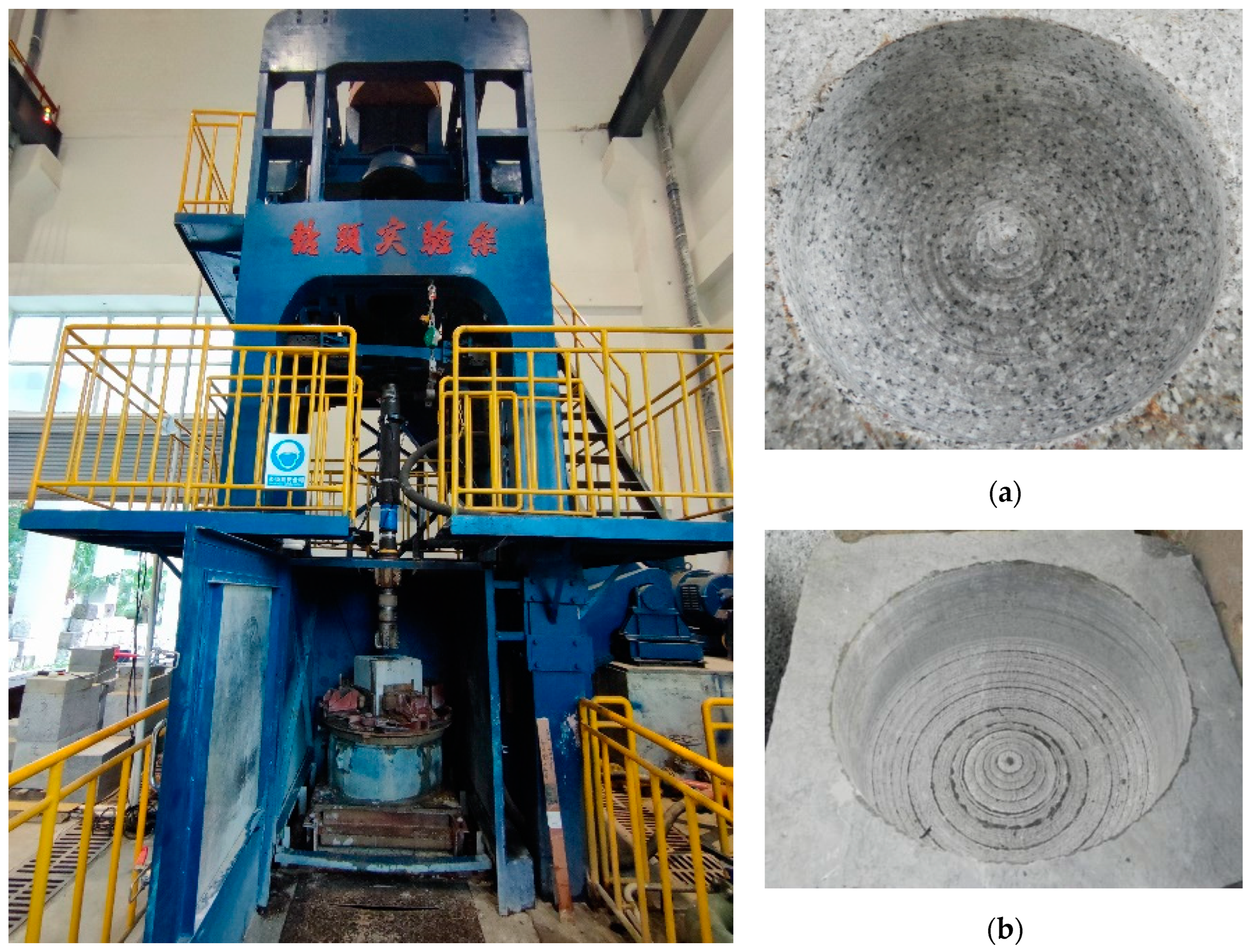

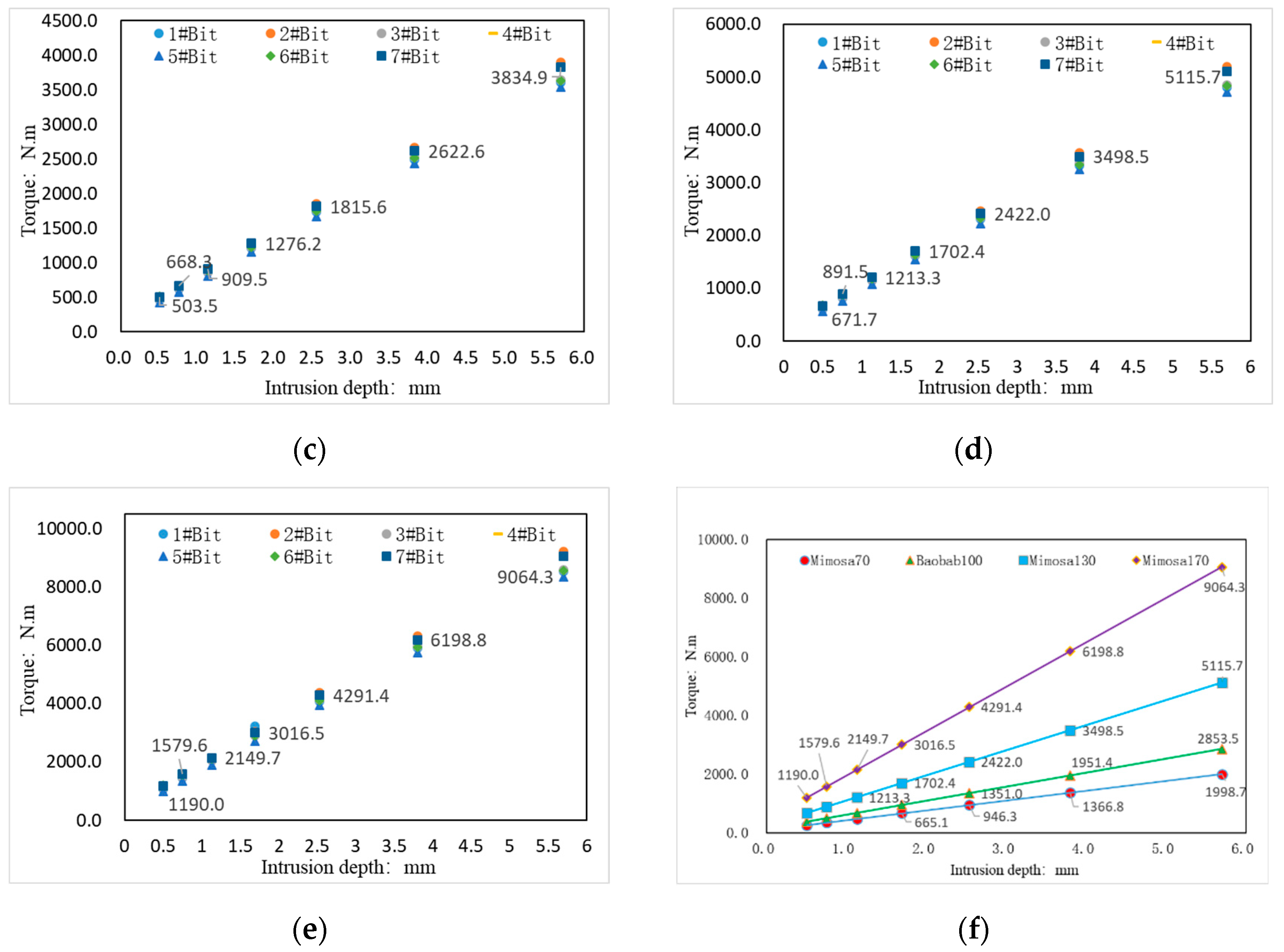
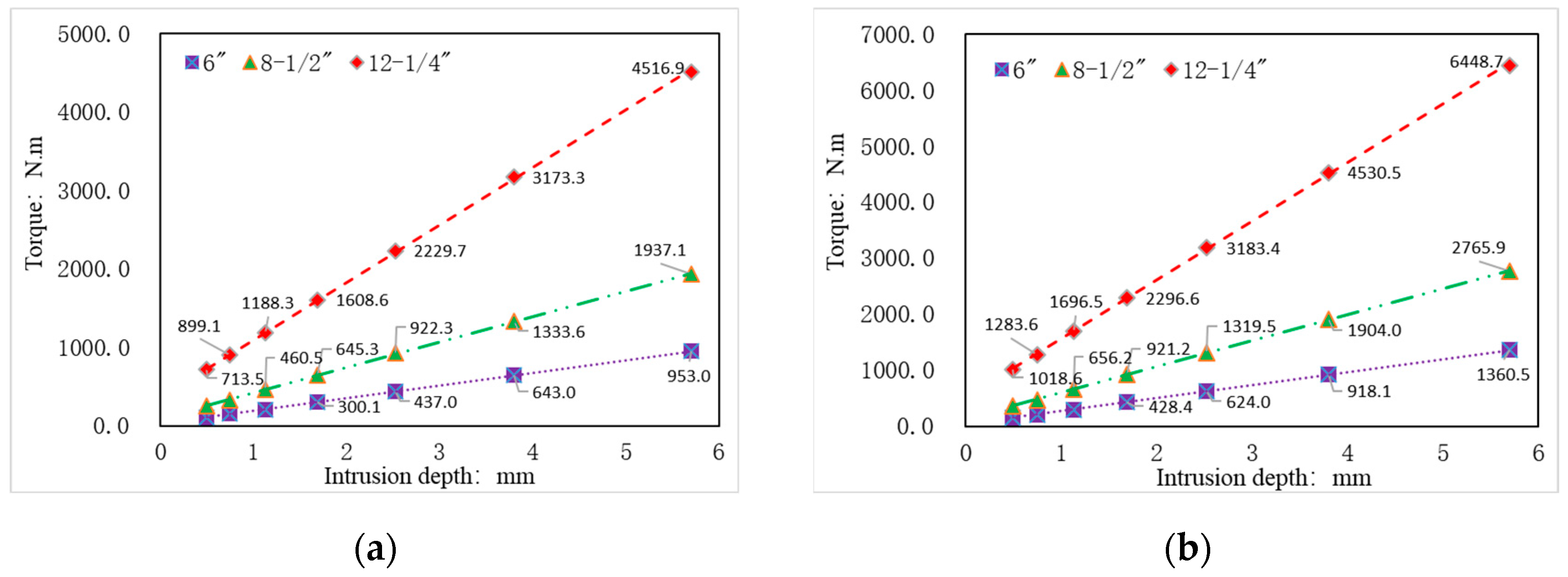
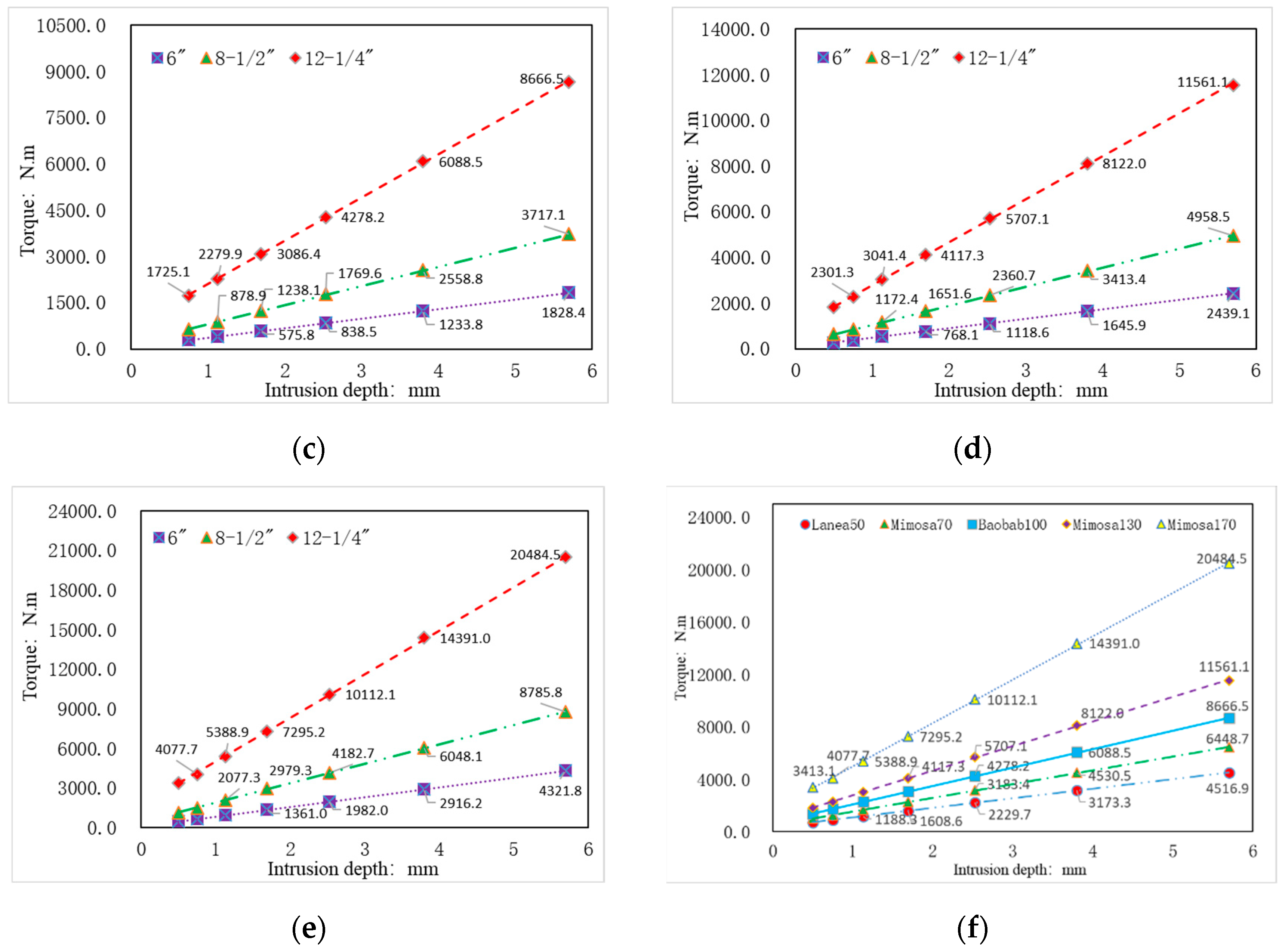
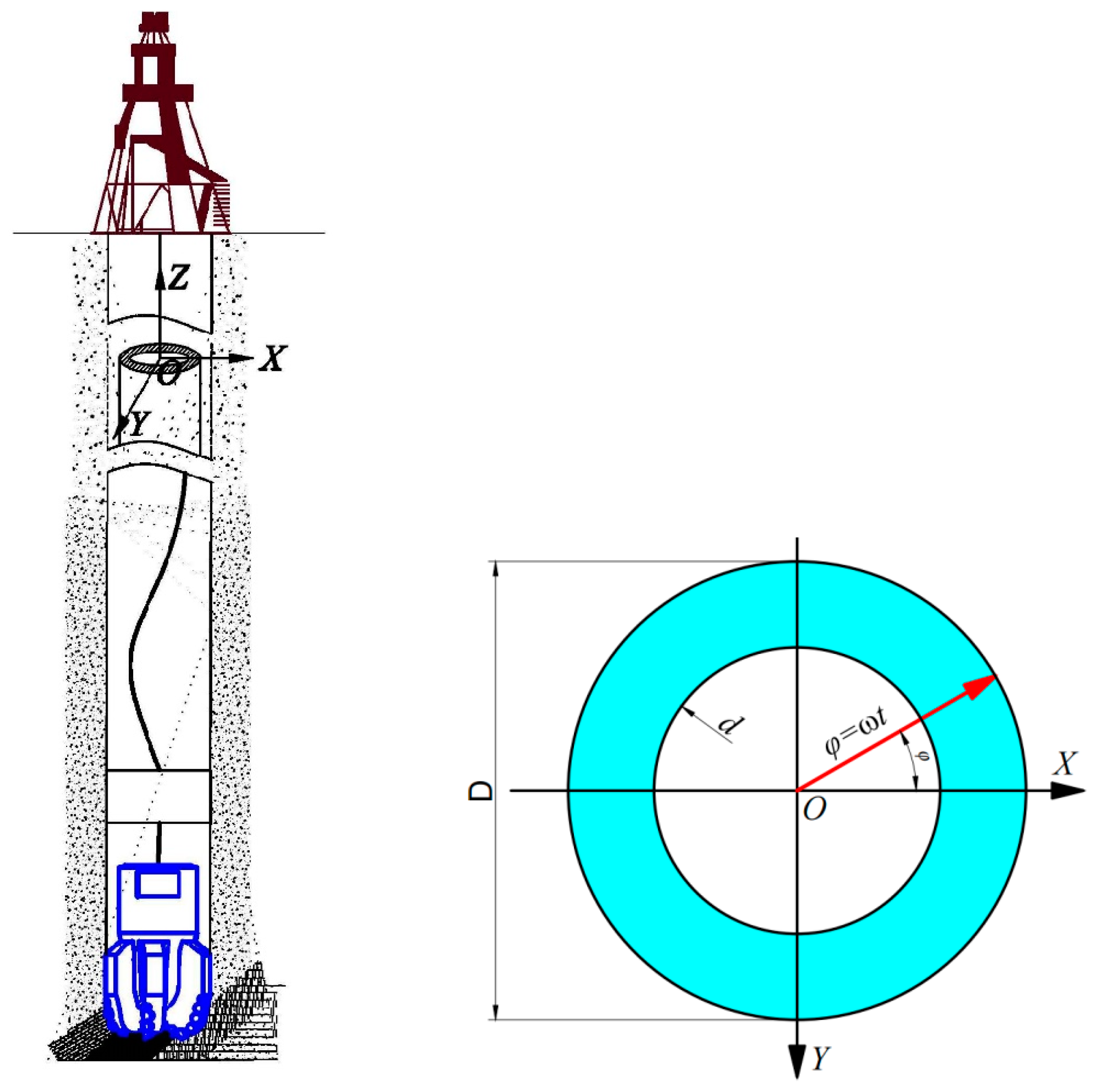

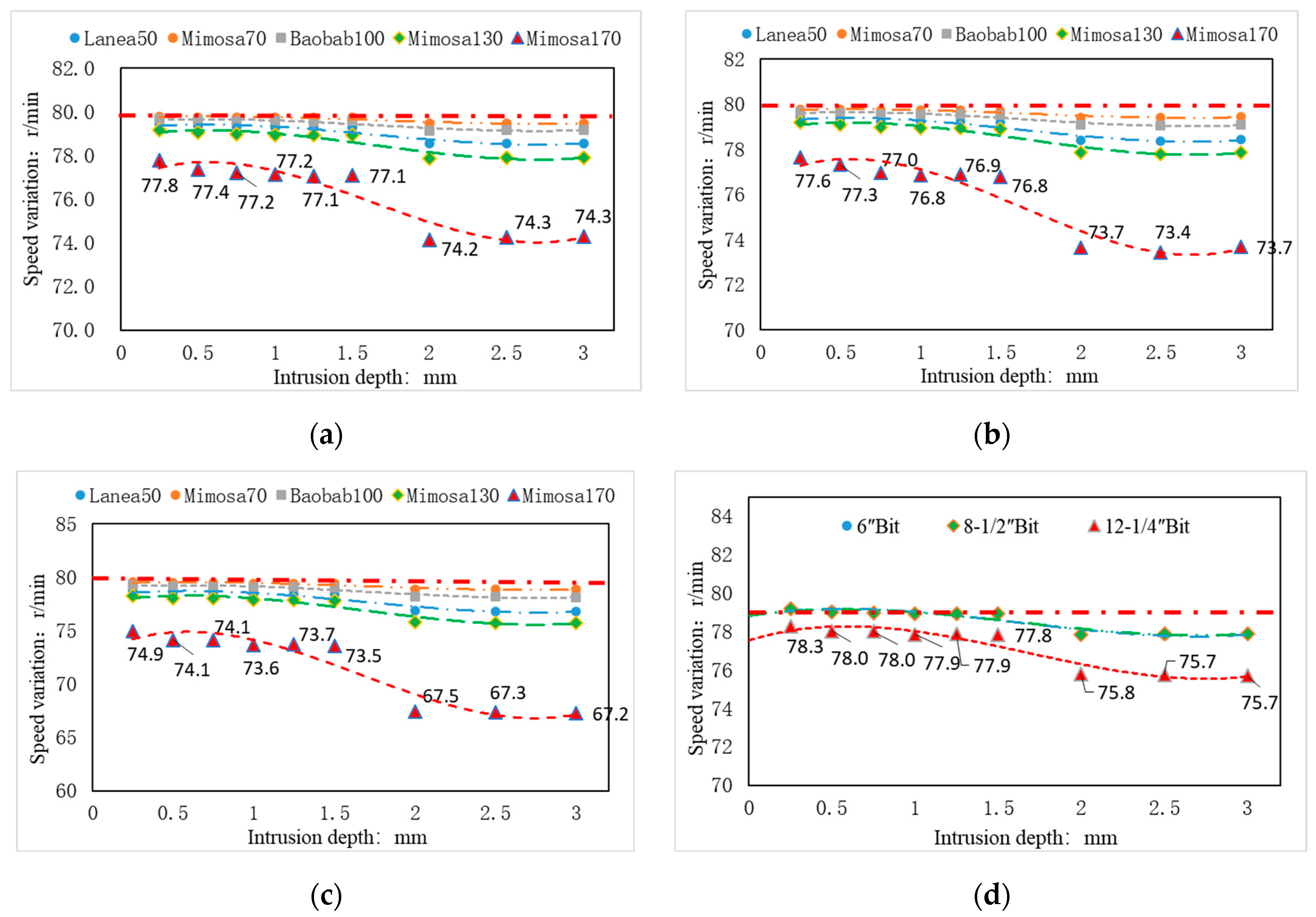
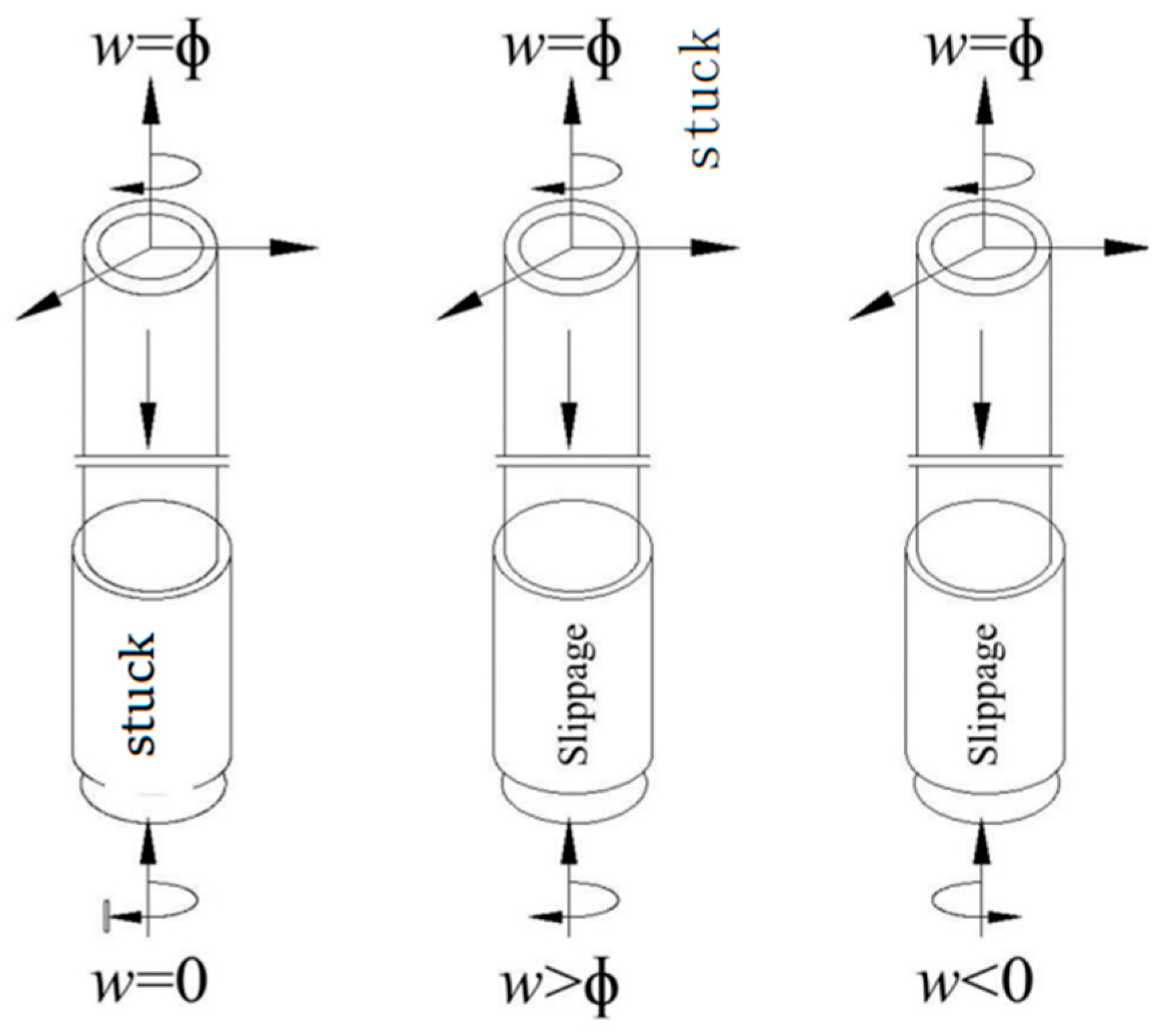
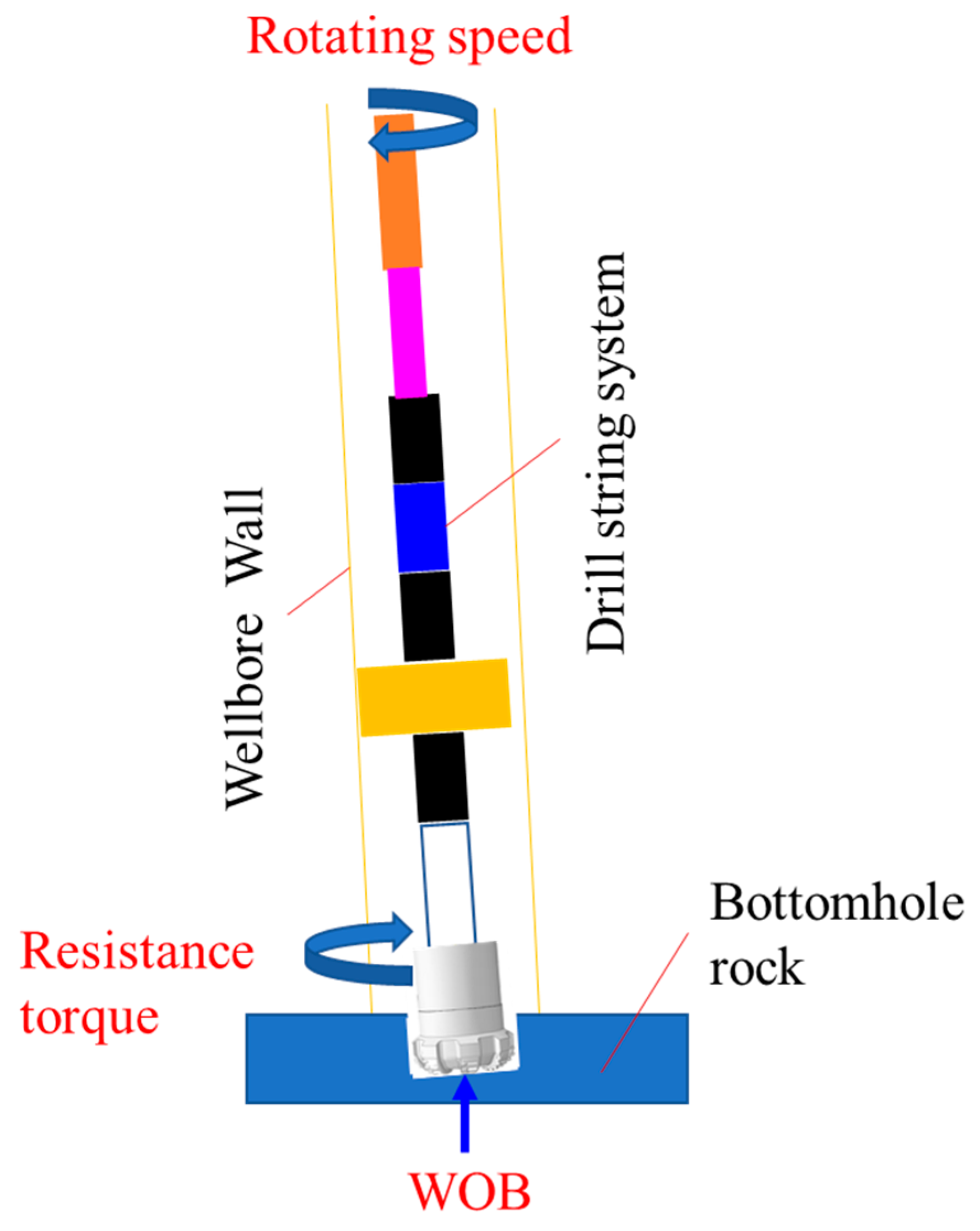



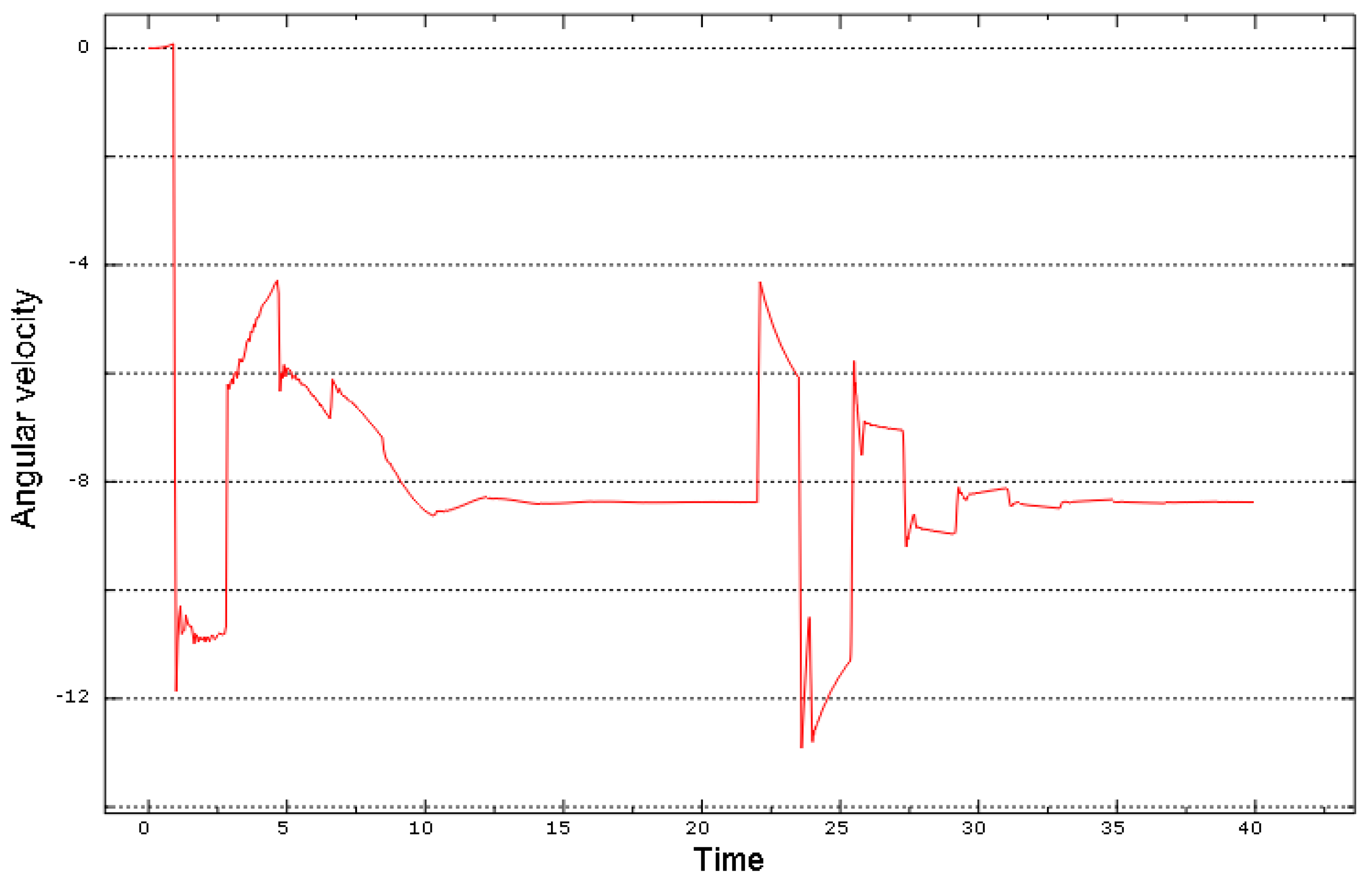
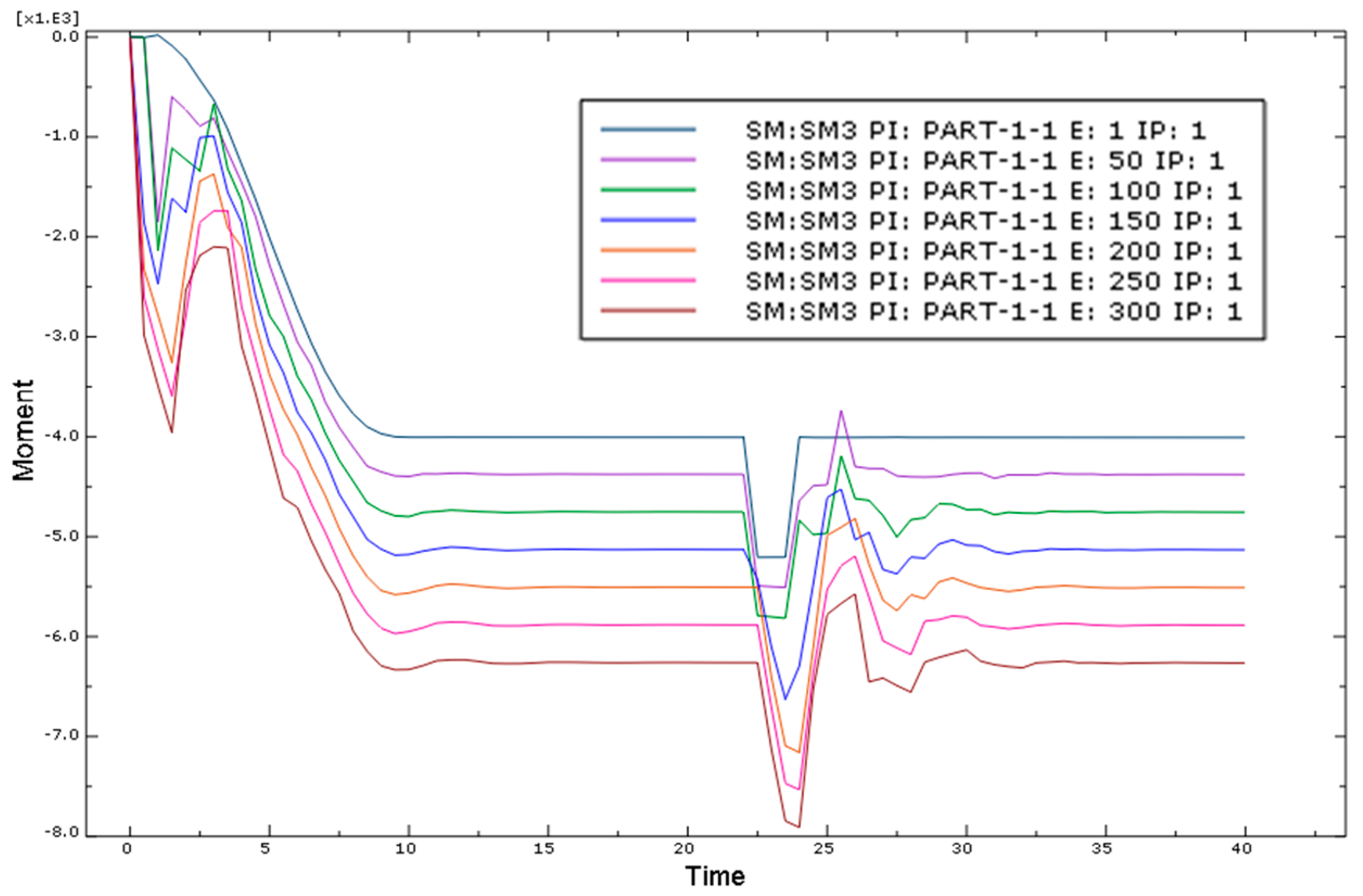
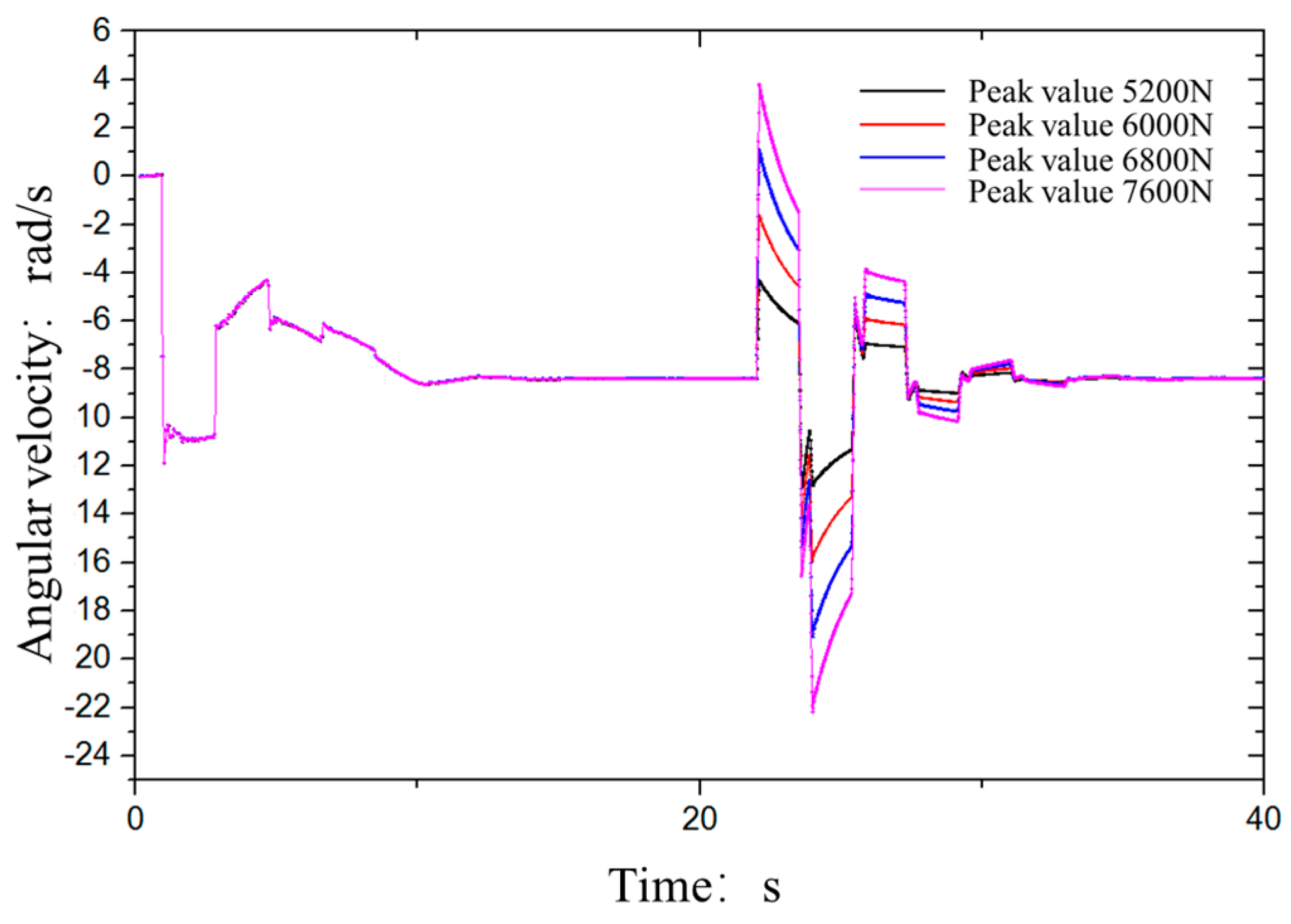

| Bit Serial Number | Model | Number of Cutting Teeth | Diameter of Cutting Teeth, mm | Remarks |
|---|---|---|---|---|
| #1 | 8½″ 604 | 19 | 19 | 4-blade, sparse tooth distribution |
| #2 | 8½″ 605 | 22 | 19 | 5-blade, sparse tooth distribution teeth |
| #3 | 8½″ 505 | 25 | 16 | 5-blade, low-densely distributed teeth |
| #4 | 8½″ 506 | 28 | 16 | 6-blade, low-densely distributed teeth |
| #5 | 8½″ 406 | 31 | 13 | 6-blade, medium-densely distributed teeth |
| #6 | 8½″ 407 | 34 | 13 | 7-blade, medium-densely distributed teeth |
| #7 | 8½″ 408 | 41 | 13 | 8-blade, highly densely distributed teeth |
| #8 | 6″ 406 | 28 | 13 | Smaller diameter size |
| #9 | 12¼″ 606 | 43 | 19 | Smaller diameter size |
| Type of Rock Block | Lanea50 | Mimosa70 | Baobab100 | Mimosa130 | Mimosa170 |
|---|---|---|---|---|---|
| Compressive strength (MPa) | 51 | 75 | 106 | 133 | 175 |
| Rock strength category | Softer | Medium softness | Hard | Medium hardness | High hardness |
| Bit Size /in | Outer Diameter /in | Inner Diameter /in | Wall Thickness /mm | Shear Modulus /Pa | Cross-Sectional Moment of Inertia / |
|---|---|---|---|---|---|
| 6″ | 3-1/2″ | 2-3/4″ | 9.35 | ||
| 8-1/2″ | 5″ | 4-1/4″ | 9.19 | ||
| 12-1/4″ |
| Name | Diameter (in) | Length (mm) | Density (kg/m3) | Elastic Modulus (Pa) | Poisson’s Ratio | Damping Coefficient |
|---|---|---|---|---|---|---|
| Drill String | 5″ | 3000 | 7900 | 0.3125 | 2 |
Disclaimer/Publisher’s Note: The statements, opinions and data contained in all publications are solely those of the individual author(s) and contributor(s) and not of MDPI and/or the editor(s). MDPI and/or the editor(s) disclaim responsibility for any injury to people or property resulting from any ideas, methods, instructions or products referred to in the content. |
© 2024 by the authors. Licensee MDPI, Basel, Switzerland. This article is an open access article distributed under the terms and conditions of the Creative Commons Attribution (CC BY) license (https://creativecommons.org/licenses/by/4.0/).
Share and Cite
Li, L.; Zhang, C.; Wu, A. Study on Mechanism of Stick–Slip Vibration Based on Torque Characteristics of PDC Bit. Appl. Sci. 2024, 14, 6419. https://doi.org/10.3390/app14156419
Li L, Zhang C, Wu A. Study on Mechanism of Stick–Slip Vibration Based on Torque Characteristics of PDC Bit. Applied Sciences. 2024; 14(15):6419. https://doi.org/10.3390/app14156419
Chicago/Turabian StyleLi, Lijun, Chunliang Zhang, and Aixuan Wu. 2024. "Study on Mechanism of Stick–Slip Vibration Based on Torque Characteristics of PDC Bit" Applied Sciences 14, no. 15: 6419. https://doi.org/10.3390/app14156419




